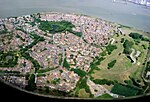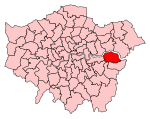Thamesmead Town F.C.
Thamesmead Town Football Club was a football club originally based in Thamesmead in south-east London before moving to Dartford in 2017. They joined the Kent League in 1991 and reached the 5th round of the FA Vase in the 1995–96 season. In the 2007–08 season, they were champions of the Kent League Premier Division and were promoted to the Isthmian League Division One North for the 2008–09 season. In the 2012–13 season, they won the Division One North play-offs and were promoted to the Isthmian League Premier Division for the first time in their history, but were relegated back after finishing 22nd the following season. The club announced it was folding in October 2018 and subsequently closed down.
Excerpt from the Wikipedia article Thamesmead Town F.C. (License: CC BY-SA 3.0, Authors).Thamesmead Town F.C.
The Ridgeway, London
Geographical coordinates (GPS) Address Nearby Places Show on map
Geographical coordinates (GPS)
| Latitude | Longitude |
|---|---|
| N 51.505033055556 ° | E 0.12972194444444 ° |
Address
The Ridgeway
SE28 8NL London (London Borough of Bexley)
England, United Kingdom
Open on Google Maps









